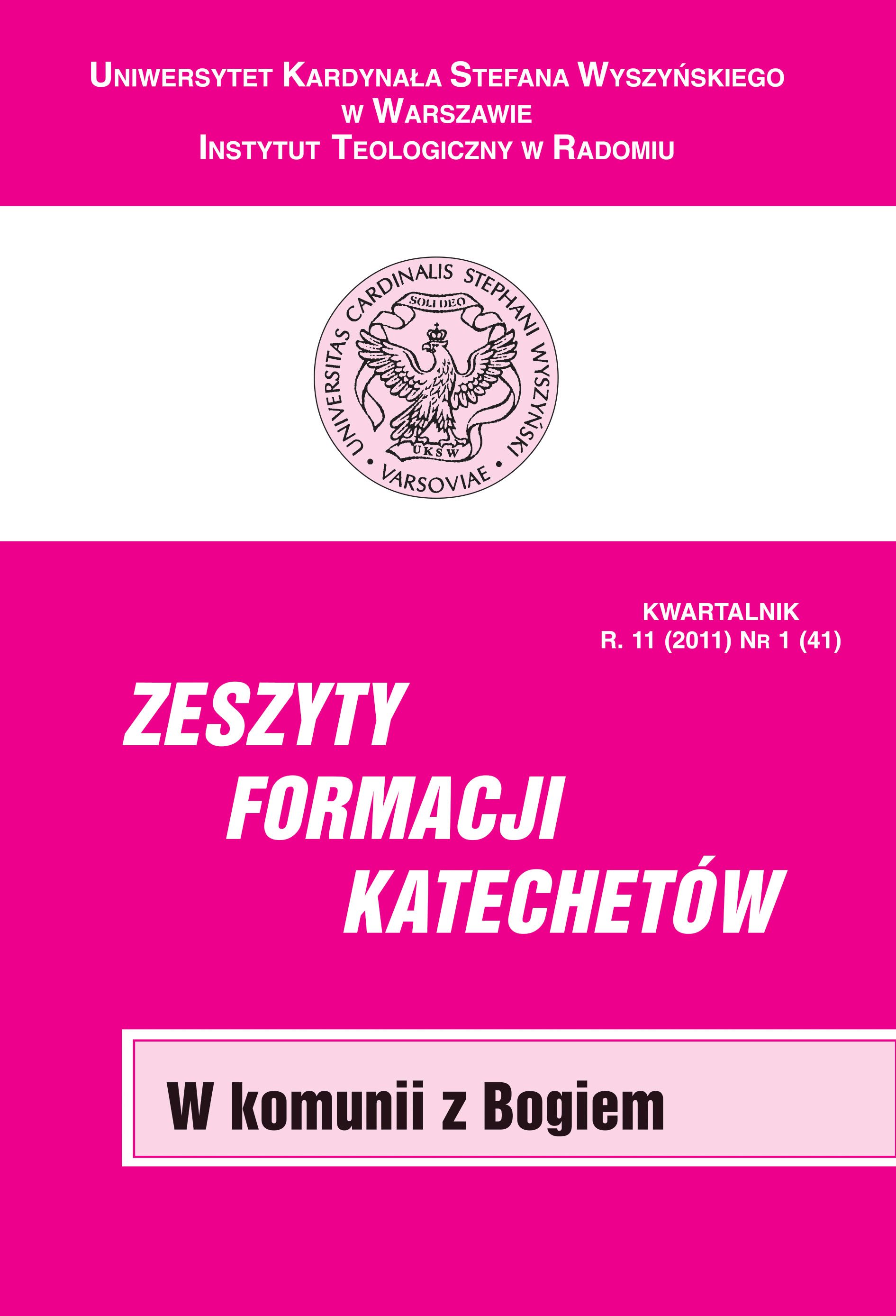Formative dimension of catechesis, liturgical year
Keywords:
liturgical year, catechesisAbstract
The liturgical year is a celebration of the mystery of Christ in time. This is possible because God entered the history of the world. The Incarnation of the Son of God has begun the implementation of the heavenly Father's plan of salvation. It culminates in the death and resurrection of Christ. These actions are saving a single and unique event. Through the liturgy, they are made present. Their update is done not by repetition, or repetition, but through sacramental reenactment. "These arguments are various celebrations, and in each one followed by the outpouring of the Holy Spirit, which updates the only mystery" (CCC 1104). So abolish the liturgical year time distance from the events of our salvation. Through the liturgy, celebrated in the discipline of faith, these events are taking place "now". Thanks to a powerful liturgical year, because sanctifying, the potential formation. Its structure, centered around the Passover of Christ, brings the faithful theological content of this mystery and put them into this mystery more deeply, to personal and personal communion with Christ the Savior in His Church. The liturgical year helps to confront his life to the word of God, which always accompanies the liturgical celebrations. The liturgical rites and attitudes taught obedience to God and to become a free gift to others (cf. Gaudium et spes, 24). In the sacred action is present because the one who came to serve (cf. Mk 10:45). Experiencing the mystery of Christ in the rhythm of the liturgical year realizes the need, indeed the necessity, the radicalism of the Gospel, therefore, adherence to the cross of Christ, the hope of sharing in his resurrection and the life in God. This radicalism will manifest an attitude of constant conversion to God, the willingness to forgive others, and making a very difficult task, namely to love, because of Christ's enemies (cf. Lk 6,27-30).
References
Baum A., Kairos, w: Praktyczny słownik biblijny, pr. zb., A. Grabner-Haidera (red.), tł. T. Mieszkowski, P. Pachciarek, Warszawa 1994, k. 535.
Bergamini A., Chrystus świętem Kościoła. Rok liturgiczny, Kraków 2003.
Cichy S., Nieszpory niedzielne w okresie wielkanocnym, „Liturgia Sacra” 1 (1995), nr ½.
Cichy S., Paschalna oś roku liturgicznego, „Anamnesis” 28 (2001/02).
Cichy S., Święci i błogosławieni w kalendarzu liturgicznym i Martyrologium rzymskim. - Zasady dotyczące wpisywania świętych i błogosławionych do kalendarza liturgicznego, „Anamnesis” 45 (2006).
Czerwik S., Misterium Adwentu i Narodzenia Pańskiego na tle prefacji, „Liturgia Sacra” 2 (1996), nr 3-4.
Czerwik S., Zbawcze misterium Chrystusa i misteria Jego życia obchodzone w cyklu roku liturgicznego, „Anamnesis” 28 (2001/02).
Danielski W., Męka Pańska w odnowionej liturgii, w: Męka Chrystusa wczoraj i dziś, red. H. D. Wojtyska, J. J. Kopeć, Lublin 1981.
Decyk J., Wielki Post drogą do Paschy Chrystusa i Kościoła, „Roczniki Teologiczne” 52 (2005), z. 8.
Głowa W., Konieczność pokuty i wychowanie do niej, „Liturgia Sacra” 2 (1999), nr 1-2.
Głowa W., Liturgia godzin w świętym Triduum paschalnym męki i zmartwychwstania Pańskiego, „Liturgia Sacra” 1 (1995), nr ½.
Jan Paweł II, Adhortacja apostolska o katechizacji w naszych czasach „Catechesi tradendae”(16.10.1979), nr 18, Watykan 1979.
Janicki J., Dominanta paschalna w niedzielnym i codziennym spotkaniu z Chrystusem, „Anamnesis” 28 (2001/02).
Kongregacja ds. Duchowieństwa, Dyrektorium ogólne o katechizacji, nr 80, Rzym 1997.
Kongregacja Kultu Bożego, List okólny o przygotowaniu i obchodzeniu świąt paschalnych(16.01.1988), nr 45, w: Święte Triduum paschalne, Materiały liturgiczno-pastoralne dla duszpasterzy i zespołów liturgicznych, red. M. Adaszek, S. Araszczuk, Legnica 1997.
Kopeć J .J., Droga krzyżowa, Niepokalanów 1994.
Krakowiak Cz., Główne treści teologiczne okresu Wielkiego Postu, „Liturgia Sacra” 2 (1999), nr 1-2.
Kubik W., Zarys dydaktyki katechetycznej, Kraków 1990.
Kudasiewicz J., Jezus historii a Chrystus wiary, Lublin 1987.
Lech, S. Wigilia Paschalna. Teologia i liturgia, „Liturgia Sacra” 1 (1995), nr ½.
Lijka K., Rewaloryzacja roli paschału w odnowionej liturgii wigilii paschalnej, Poznań 2007.
Miazek J., Uroczystość i oktawa Bożego Narodzenia w modlitwach Mszału Pawła VI, „Liturgia Sacra” 4 (1996), nr 2.
Nadolski B., Leksykon liturgii, Pallottinum, Poznań 2006.
Nadolski B., Miejsce świętych w liturgii a współczesny chrystocentryzm, „Anamnesis” 40 (2005).
Ogólne normy roku liturgicznego i kalendarza (= ONRLK, 14.02.1969), nr 18.
Pierskała R., Misterium Paschalne w znakach liturgii Wielkiej Nocy, „Liturgia Sacra” 1 (1995), nr 1/2,
Pius XII, Encyklika o liturgii Mediator Dei, nr 49, http://ekai.pl (z dn. 12.10.2009).
Sinka T., Gorzkie żale. Geneza, teologia, przyszłość, „Ruch Biblijny i Liturgiczny” 1 (2001).
Sobeczko H. J., Naśladowanie Chrystusa w tajemnicach Jego życia uobecnionych w roku liturgicznym, „Anamnesis” 28 (2001) nr 2.
Sroka J., Teologiczne treści adwentu i okresu Bożego Narodzenia, „Anamnesis” 13 (1997/1998).
Szlaga J., Czas narodzin Jezusa Chrystusa, „Znak” 29 (1977).
Świerzawski W., Gloria passionis. Chrystus obecny w liturgii i życie chrześcijańskie, Częstochowa 1987.
Świerzawski W., Święte misterium paschalne dominantą roku liturgicznego, „Anamnesis” 9 (1996/1997).
Wit Z., Jak święci szli śladami Chrystusa w roku liturgicznym, „Anamnesis” 28 (2001/02).
Downloads
Published
How to Cite
Issue
Section
License
Copyright (c) 2011 KATECHISTS' PERIODICAL

This work is licensed under a Creative Commons Attribution-NonCommercial-NoDerivatives 4.0 International License.

